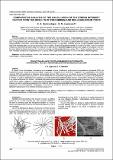| dc.contributor.author | Sadovskaya, Elena Alexandrovna | |
| dc.contributor.author | Leonovich, Sergey Nikolaevich | |
| dc.coverage.spatial | Brest | ru_RU |
| dc.date.accessioned | 2023-03-07T07:30:32Z | |
| dc.date.available | 2023-03-07T07:30:32Z | |
| dc.date.issued | 2022 | |
| dc.identifier.citation | Sadovskaya, E. A. Comparative analysis of the calculation of the stress intensity factor from the results of equilibrium and non-equilibrium tests / E. A. Sadovskaya, S. N. Leonovich // Vestnik of Brest State Technical University. – Brest : BrSTU, 2022. – № 3. – P. 12–15. – Bibliography: p. 15 (12 titles). | ru_RU |
| dc.identifier.uri | https://rep.bstu.by/handle/data/32737 | |
| dc.description | Sadovskaya E. A., Leonovich S. N.Сравнительный анализ расчета коэффициента интенсивности напряжений по результатам равновесных и неравновесных испытаний | ru_RU |
| dc.description.abstract | This article explores the practical use of methods for determining the stress intensity factor at normal separation: eccentric compression of notched cubes and four-point bending of a notched beam. During non-equilibrium tests, the stress intensity factor value was calculated from the value of the breaking load. During equilibrium tests, the stress intensity factor value was determined from the complete equilibrium deformation diagram, taking into account the energy indicators of destruction. The test used nanofiber-reinforced concrete, in which carbon nanotubes are used as crack propagation inhibitors at the level of the cementing agent, and various macro-sized fibers are used at the level of fine-grained concrete. As a result of the tests, it was found that the methods for determining the recovery factor from cubes with a notch and from deformation diagrams showed a good degree of convergence. Fiber reinforcement affects the fracture toughness of a nanocement composite, and high-modulus fiber has a greater effect on fracture toughness than low-modulus fiber. The stress intensity factor is a good indicator for comparing different types of fiber reinforcement in terms of their effect on fracture toughness. | ru_RU |
| dc.language.iso | en | ru_RU |
| dc.publisher | BrSTU | ru_RU |
| dc.subject | nanofibre-reinforced concrete | ru_RU |
| dc.subject | нанофибробетон | ru_RU |
| dc.subject | трещиностойкость | ru_RU |
| dc.subject | crack resistance | ru_RU |
| dc.title | Comparative analysis of the calculation of the stress intensity factor from the results of equilibrium and non-equilibrium tests | ru_RU |
| dc.title.alternative | Сравнительный анализ расчета коэффициента интенсивности напряжений по результатам равновесных и неравновесных испытаний | ru_RU |
| dc.type | Статья (Article) | ru_RU |
| dc.identifier.udc | 693.554-486 | ru_RU |
| dc.abstract.alternative | В данной статье исследовано практическое использование методов определения коэффициента интенсивности напряжений (КИН) при нормальном отрыве: внецентренное сжатие кубов с надрезами и четырехточечный изгиб балки с надрезом. При неравновесных испытаниях значение КИН рассчитывалось по величине разрушающей нагрузки. При равновесных испытаниях величина КИН определялась из полной равновесной диаграммы деформирования с учетом энергетических показателей разрушения. В испытании использовался нанофибробетон, в котором на уровне цементирующего вещества в качестве ингибиторов распространения трещин используются углеродные нанотрубки, а на уровне мелкозернистого бетона – различные фибровые волокна макроразмера. В результате испытаний установлено, что методы определения КИН по кубам с надрезом и по диаграммам деформирования показали хорошую степень сходимости. Фибровое армирование оказывает влияние на вязкость разрушения наноцементного композита, причем высокомодульная фибра оказывает большее влияние по показатель вязкости разрушения, чем низкомодульная. Коэффициент интенсивности напряжений является хорошим показателем для сравнения разных типов фибрового армирования по их влиянию на вязкость разрушения. | ru_RU |
| dc.identifier.doi | https://doi.org/10.36773/1818-1112-2022-129-3-12-15 | |
